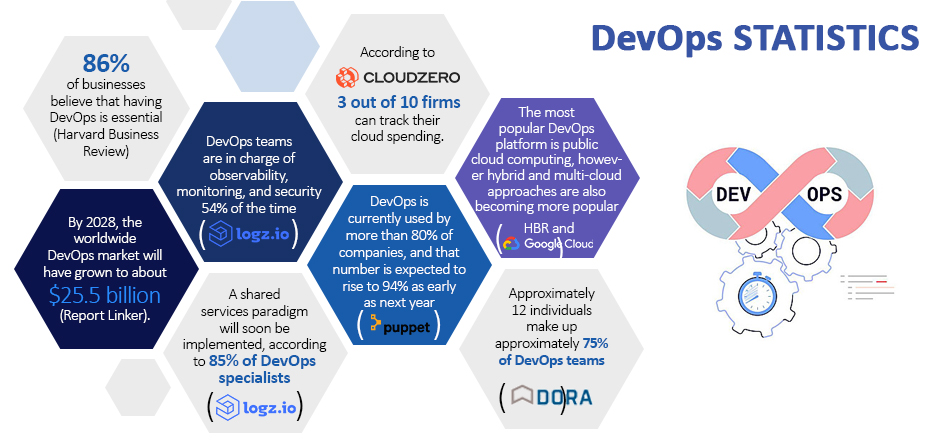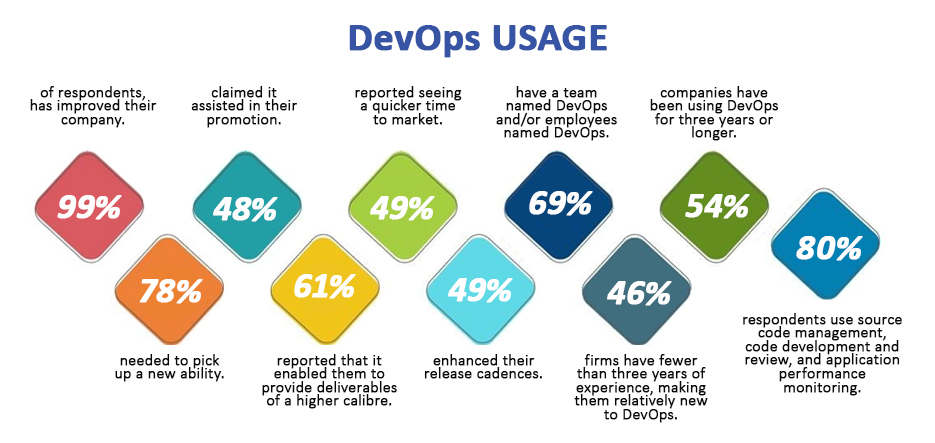Table of Contents
In today’s fast-paced digital scenario, organizations are continually striving to convey top-notch items and services at a pace. Furthermore, this requirement for speed and productivity has led to the ascent of DevOps. A philosophy that shines out software development and task processes. By incorporating cloud innovation with DevOps rehearses, cloud consulting companies can accomplish further developed efficiency levels and drive development.
What Is DevOps?
DevOps is a product development philosophy that joins development (Dev) and tasks (Operations) to cooperate all through the software development lifecycle. Overall, it focuses on collaborated effort, automation, and constant delivery to convey great software at a faster speed.
According to the DORA Research 2023, organizations that have successfully implemented DevOps practices experience:
– more frequent deployments on demand
– 5% lower change failure rates
– Failed deployment recovery rate :Less than 1 hour
– Lead time for changes: Less than 1 day
These measurements feature the critical effect that DevOps can have on an association’s efficiency and proficiency. Overall, by separating storage among development and task groups, DevOps services and solutions joint effort and communication, lead to quicker development cycles and speedy delivery.
Integration of Cloud DevOps automation:
The integration of cloud innovation with DevOps has additionally concerned the product development scene. Cloud computing permits organizations to deal with their assets, like servers, organizing, and data sets, over the web instead of depending on actual foundations.
By utilizing cloud innovation in DevOps processes, DevOps consulting companies can profit from extended versatility, adaptability, and cost viability. The cloud furnishes creators with on-request access to resources, permitting them to rapidly scale foundations depending on the situation. Furthermore, this wipes out the requirement for manual supply solutions and decreases lead time for development projects.

How Does DevOps Work?
DevOps, short for development and Operations, is a philosophy that plans to further develop collaborated effort and communication between software development groups. It unites the customarily siloed jobs of developers and framework heads to make a smooth and effective software development process. Overall, DevOps is frequently combined with cloud computing to additional upgrade efficiency.
Here are the standards associated with how DevOps functions:
1. Planning:
The most important phase in the DevOps cycle is planning. This includes recognizing project necessities, putting forth objectives, and illustrating the tasks and achievements that should be accomplished. The planning stage incorporates making a guide for the development cycle, deciding on resource distribution, and assessing timetables and financial plans.
During this stage, key partners from both the turn of events groups meet up to adjust their goals and lay out a common vision for the venture.
2. Development:
When the planning stage is finished, the development stage starts. This is where the genuine coding and software of the product happens. Furthermore, development groups work on making and carrying out new features, fixing bugs, and persistently working on the product.
The DevOps approach stresses joint effort among developers and activity groups during this stage. Developers compose code that is effectively deployable and adaptable. Task groups give the fundamental foundation and devices for the code to run as expected under conditions.
3. Testing:
Testing is a critical step toward the DevOps cycle. It includes confirming that the product meets the requirements, is free from bugs, and proceeds true to form. Different testing strategies, for example, unit testing, coordination testing, and execution testing are utilized to guarantee the nature of the product.
Mechanized testing is a vital part of DevOps, as it considers quicker and more regular testing cycles. Overall, persistent integration devices are utilized to assemble and test the code at whatever point changes are made. Guaranteeing that any issues or bugs are recognized and settled right off the bat in the cloud application development cycle.
4. Deployment:
When the product has been entirely tried and meets all requirements, it is prepared for solutions. Deploying includes making the product accessible for end-clients to access and utilize. Overall, in a DevOps environment, an organization is commonly computerized utilizing ceaseless mix/persistent CI/CD pipelines.
The CI/CD takes into account the consistent and productive organization of software refreshes. It robotizes the most common way of building, testing, and transferring code changes to creation conditions. Furthermore, this guarantees that new feature fixes are conveyed rapidly, limiting free time and interruption for end clients.
5. Monitoring:
After organization, the product is persistently observed to guarantee its presentation, accessibility, and cloud computing security. Checking includes gathering and investigating information on different measurements, for example, framework uptime, reaction times, mistake rates, and client criticism.
DevOps services use observing tools and methods to distinguish any issues in the product and make moves to streamline its exhibition. Overall, this can incorporate scaling assets, applying patches or updates, and tending to any security weaknesses.
Checking likewise helps in distinguishing patterns in client conduct, which can be utilized to improve the product and give a superior client experience. It gives significant experiences into how the product is being utilized and considers information-driven navigation.
Key DevOps Practices
1. Continuous Integration (CI):
Continuous Integration is a development practice that includes consolidating code changes from different developers into a focal store. Overall, the point is to empower the early location of integration issues and clashes, guaranteeing that the DevOps and software development interaction stays smooth. CI diminishes the dangers related to manual coordination and permits groups to convey software quickly.
2. Continuous Delivery (CD):
Continuous Delivery in DevOps service providers expands on the idea of constant combination via computerizing the whole software discharge process. It includes routinely conveying code changes to creation conditions solidly and proficiently.
A continuous delivery guarantees that the product is generally in a deployable state, with any essential conditions currently set up. This training assists groups with deploying new features, bug fixes, and enhancements to end clients rapidly and reliably.
3. Infrastructure as Code ( IaC):
Infrastructure as Code is a training that includes provisioning framework assets utilizing code and setup records. Rather than physically setting up and designing servers, organizations, and other framework parts, IaC takes into consideration the computerization of these projects through code. This guarantees consistency, detectability, and repeatability in the deployment system, lessening human errors and empowering quicker provisioning of assets.
4. Continuous Testing:
Continuous Testing is vital for DevOps interaction, guaranteeing that the product is completely tried at each progressive phase. Furthermore, this training includes computerizing the testing system to rapidly and precisely recognize any deformities or issues in the code.
Overall, by carrying out an exhaustive set-up of computerized tests, including unit tests, incorporation tests, and execution tests, groups can recognize and, work on the general nature of the product. Constant testing likewise considers faster input on code changes, empowering developers to make vital changes and fixes before the product is sent to creation.
5. Continuous Checking:
Continuous Checking includes continually observing the production, accessibility, and security of the product’s underway conditions. This training guarantees that any issues are distinguished and tended to immediately, limiting personal time and further developing the general client experience. Constant observation includes collecting and breaking down data on different sizes.
For example, framework uptime, reaction times, mistake rates, and client input. This information gives significant insights into how the product is performing and considers proactive activities to boost its exhibition. Overall, by observing the product persistently, DevOps consultants can recognize patterns in client conduct, which can be utilized to improve the product and give a superior client experience.
6. Collaboration and Communication:
Effective collaboration and communication are fundamental for effective DevOps. This includes encouraging a culture of collaboration, transparency, and open communication between creators, operation groups, and different members.
Furthermore, cooperative devices like chat platforms, project management software, and version control systems can work with effective communication and coordination.
Customary meetings, stand-ups, and reviews can likewise assist with guaranteeing that everybody is adjusted and pursuing similar objectives. By advancing cooperation and communication, groups can stay away from miscommunication, diminish bottlenecks, and streamline the development cycle.

The Connection Between DevOps and the Cloud
1. Infrastructure as Code (IaC):
The cloud gives a versatile foundation, considering the mechanization of framework provisioning and the executives. Overall, this lines up with the standards of DevOps, where the framework is treated as code. DevOps groups can without much of a stretch make, transmit, and deal with their framework utilizing tools like Terraform or AWS CloudFormation.
2. Continuous Integration and Continuous Delivery:
The cloud empowers groups to handily fabricate, test, and persistently send their applications. Furthermore, DevOps solutions can use cloud-based services like AWS CodePipeline or Azure DevOps to computerize the whole software delivery process. Overall, this considers quicker and more regular deliveries, diminishing the chance to showcase and expand spryness.
3. Adaptability and Versatility:
Adaptability and versatility are key advantages of incorporating the cloud with DevOps. With a customary on-premises foundation, scaling assets to satisfy developed needs can be a complex and tedious interaction. In any case, with the cloud, groups can undoubtedly increase or decrease their assets in light of current requirements.
Cloud suppliers offer many cloud computing services that take into account consistent versatility. For instance, AWS Auto Scaling permits groups to consequently change the number of examples in light of constant interest. Overall, this adaptability empowers DevOps groups to rapidly answer changing business necessities and guarantee ideal asset use.
4. Cost Optimization:
The cloud offers cost development and open doors for DevOps groups. With the conventional framework, associations need to put resources into equipment and maintenance costs, paying little emphasis to utilization. In any case, with the cloud, groups can pay for resources on a pay-as-you-go model. Just paying for what they use. This decreases costs and works on cost productivity.
Cloud suppliers additionally offer devices and services for observing and improving asset utilization. DevOps groups can use these devices to distinguish areas of defects and streamline their framework appropriately. By enhancing asset assignment and decreasing waste, associations can altogether bring down their general expenses.
5. Collaboration and Visibility:
The cloud gives cooperative devices and platforms that work with transparency among colleagues. Furthermore, DevOps groups can utilize cloud-based projects, the executive’s software, and form control frameworks to team up and monitor progress.
Cloud platforms additionally offer concentrated observing abilities, permitting groups to acquire visibility in the presentation and well-being of their applications. This empowers quicker identification of issues and faster goals, limiting margin time and further developing general framework dependability.
6. Security and Compliance:
Coordinating the cloud with DevOps takes into consideration improved security and compliance. Cloud suppliers offer robust safety efforts, for example, encryption, access controls, and danger discovery, to guarantee the security of information and applications.
DevOps groups can use these innate security features to upgrade the security viewpoint of their applications. Furthermore, via robotizing security processes through constant coordination and continuous delivery, companies can guarantee that safety efforts are reliably applied all through the development lifecycle.
Cloud DevOps consulting and its suppliers additionally offer compliance commitments and systems that assist companies with meeting industry-explicit guidelines and norms. DevOps groups can use these assets to guarantee their applications consent to important security and protection requirements.
Accelerate Your Software Development Process with Our DevOps Services
Benefits of Cloud-Based DevOps
Cloud-based DevOps refers to the combination of cloud computing innovation with DevOps practices to improve software development and solutions processes. This blend offers various advantages that can essentially further develop efficiency inside associations.
1. Versatility:
Cloud platforms give flexible assets that can be handily increased or down in light of project requirements. With cloud-based DevOps, groups can rapidly solve extra servers or foundation assets while required, guaranteeing ideal execution and accessibility. This adaptability considers the professional treatment of high-traffic or expanded jobs, bringing about better efficiency.
2. Cost Effectiveness:
Cloud-based DevOps kills the requirement for direct interest in equipment and framework. Organizations can rather use cloud services on a pay-as-you-go model, paying just for the assets they use. This cost-effectiveness limits wastage and lessens large costs, permitting associations to spread their financial plan all the more actually and put resources into different regions of the business.
3. Quicker Time to Market:
By utilizing cloud-based DevOps, groups can shorten the turn of events and organization cycles. Furthermore, the cloud gives on-request access to assets and foundations, empowering quicker provisioning and solutions. Overall, this considers speedier testing, sending, and the arrival of software refreshes or new highlights, bringing about a quicker time to showcase and an upper hand on the lookout.
4. Increased Collaboration:
Cloud-based DevOps promotes cooperation among colleagues, no matter what their topographical area. With cloud-based project management devices and communication platforms, groups can undoubtedly work together on code, track progress, and offer support. This joint effort further develops communication and cooperation, leading to improved efficiency and quicker delivery of software projects.
5. Further developed Adaptability:
Cloud-based Dev Operations offers adaptability concerning development and organization. Groups can undoubtedly try different things with various solutions, conditions, and devices without the requirement for the actual foundation. This adaptability considers quicker development and variation to changing business sector needs, bringing about better efficiency.
6. Improved Testing:
Cloud-based DevOps empowers groups to perform comprehensive testing all through the development lifecycle. With cloud assets, groups can establish test conditions that reflect creation conditions and effectively increase them or down on a case-by-case basis.
Overall, this takes into account the intensive testing of software applications under various circumstances, ensuring their quality and dependability. Furthermore, by recognizing and resolving issues from the get-go, groups can create potential product disappointments and work on the general execution of their applications.
7. Efficient Continuous Integration and Delivery:
With cloud-based DevOps, groups can mechanize the most common way of coordinating code changes, running tests, and sending applications to creation conditions. This persistent mix of CI/CD approach takes out manual tasks and diminishes the risk of mistakes or irregularities. Via computerizing these cycles, groups can guarantee quicker and more continuous deliveries, leading to further developed efficiency and quicker time to showcase.
8. Further developed Security:
Cloud-based DevOps offers upgraded safety efforts contrasted with conventional on-premises foundation. Cloud suppliers put vigorously in safety efforts, for example, information encryption, access controls, and danger identification frameworks. By utilizing cloud-based DevOps, associations can profit from these strong safety efforts without the requirement for extra venture or mastery.
Furthermore, this better security safeguards sensitive information and protections against potential digital dangers, guaranteeing business congruity and decreasing the risk of excessive security breaches.
Security In The Cloud and DevOps
– Execute solid access controls:
Use multifaceted verification, job-based access control, areas of strength, and strategies to guarantee that just-approved people approach cloud assets.
– Encrypt data in transit and at rest:
Use encryption routines like SSL/TLS for information transmission and encryption calculations for information capacity to safeguard sensitive data from unapproved access.
– Regularly update and patch systems:
Keep cloud foundation and software fully informed regarding the most recent security fixes and updates to address any known weaknesses.
– Conduct regular vulnerability assessments and penetration testing:
Set up observing instruments and frameworks that can identify and build unapproved access endeavors or suspicious exercises inside the cloud environment.
– Direct customary weakness evaluations and infiltration testing:
Routinely survey the cloud security consulting of your cloud framework and applications by leading weakness outputs and entrance tests. Overall, this distinguishes any shortcomings or potential passage focuses that attackers could take advantage of and considers convenient relief measures to be carried out.
– Carry major areas of strength for our safety efforts:
Use firewalls, VPNs, and network division to shield cloud assets from unapproved access and organization assaults.
-Implement data loss prevention (DLP) measures:
Use DLP answers to screen and control the development of sensitive information inside the cloud environment, forestalling unapproved disclosure or spillage of sensitive data.
– Execute powerful logging and monitoring:
Set up logging and DevOps monitoring frameworks to follow and break down exercises inside the cloud environment. Furthermore, this distinguishes any dubious or odd behavior and considers convenient reaction and remediation.
– Routinely backup data:
Execute customary data support to guarantee that in case of a security episode or framework disappointment, information can be immediately reestablished without critical misfortune.
– Educate and train employees on security best practices:
Give normal preparation and schooling to workers on the significance of safety in the cloud environment. Overall, DevOps cloud services incorporate themes like secret key cleanliness, phishing mindfulness, and social designing methods.
– Implement incident response and disaster recovery plans:
Create and routinely test occurrence reactions intended to guarantee a convenient and powerful reaction to security occurrences. Moreover, design mishap recovery intends to limit personal time in case of a framework disappointment or information break.
Use Cases Of DevOps
1. Healthcare:
The National Health Service (NHS) in the UK carried out DevOps practices to further develop their software delivery processes. They faced difficulties with long organization processes and continuous service delays. By embracing DevOps, they achieved quicker and more solid services, bringing about superior patient care and decreased costs.
2. Automobile:
Another significant automobile manufacturer, for example, Mercedes Benz, sensed the requirement for DevOps methods to upgrade their software development and testing processes. They confronted difficulties with slow complaint processes and the absence of collaboration among improvement and operations groups.
By taking on DevOps standards, they had the option to lay out cross-utilitarian groups that worked cooperatively all through the software development lifecycle. This empowered quicker recognizable proof and goal of issues, bringing about better vehicle performance and consumer loyalty.
3. E-commerce:
A well-known online retailer, like Amazon, embraced DevOps to smooth out their software progress and launching pipeline. By executing constant incorporation and delivery, they had the option to deliver new features and updates to their site and mobile applications rapidly. This permitted them to remain serious in the quick-moving online business industry and further develop the general client experience.
4. Finance:
A main financial foundation used DevOps to further develop its software development and launching processes. They confronted difficulties with slow delivery processes and successive framework disappointments, which harmed consumer loyalty and productivity.
By executing DevOps practices, they had the option to mechanize their delivery interaction, lessen margin time, and work on the dependability of their frameworks. This permitted them to convey new financial items and management quicker, bringing about expanded consumer loyalty and revenue.
Overall, these case studies show the various uses of DevOps across different enterprises. From healthcare to automobile, e-commerce to finance, organizations are utilizing DevOps practices to smooth out their software development and organization processes, further develop framework unwavering quality, and improve client encounters.
By embracing a culture of cooperation, robotization, and nonstop improvement, organizations can accomplish huge advantages as far as cost decrease, quicker time to showcase, expanded consumer loyalty, and further developed general business execution. DevOps isn’t restricted to a particular industry or area however can be applied across different spaces to drive development and achievement.
Emerging Trends In Cloud And DevOps
1. Shift towards serverless design:
One arising pattern in the integration of cloud and DevOps is the shift towards serverless engineering. Serverless computing permits developers to focus on composing code without worrying about overseeing servers or foundations. This pattern empowers quick solutions and adaptability, leading to further developed efficiency.
2. Microservices design:
Microservices engineering is acquiring omnipresence in the mix of cloud and DevOps because of its versatility and adaptability. With this methodology, applications are separated into more subtle, free cloud-based services that can be created, sent, and overseen independently. Overall, this takes into account quicker development cycles, more precise maintenance, and better flexibility to dissatisfactions.
3. DevSecOps:
Security is turning into a vital piece of the integration of cloud and DevOps. DevSecOps highlights the significance of coordinating security rehearses all through the product development lifecycle, as opposed to regarding it as a bit of hindsight. Overall, this pattern guarantees that safety efforts are executed from the beginning and are ceaselessly observed and refreshed, diminishing the risk of safety defects.
4. Kubernetes and containerization:
Kubernetes has arisen as a well-known device for overseeing and managing holders in cloud shapes. Furthermore, containerization considers simple solutions and scaling of uses, giving associations expanded adaptability and proficiency in their turn of events and activities processes.
5. Artificial intelligence and machine learning in DevOps:
The combination of artificial intelligence and ML in DevOps is another emerging pattern. Artificial intelligence and ML can be utilized to mechanize different tasks in the product development lifecycle, for example, code surveys, testing, and deploying. This can enormously further develop efficiency by lessening manual work and empowering groups to focus on additional complicated projects.
6. ChatOps:
ChatOps is the act of utilizing chat platforms, like Slack or Microsoft Teams, to facilitate communication and collaboration within the DevOps team. ChatOps considers ongoing communication, consistent combination with different tools and frameworks, and the capacity to robotize assignments through chatbots. This pattern further develops group cooperation, transparency, and productivity in dealing with the turn of events and sending processes.
Minimize DownTime and Increase Efficiency With Our DevOps Solutions and Services
Final Thoughts
Overall, the integration of cloud and DevOps has shown to be a unique advantage for organizations hoping to further develop efficiency. By utilizing the versatility and adaptability of the cloud, organizations can consistently launch applications and foundations, considering quicker development cycles and a speedier chance to showcase. Furthermore, with the collaborated effort and computerization capacities presented by DevOps, groups can work all the more productively and really, leading to expanded efficiency and the capacity to convey top-notch software at a quicker pace.
The integration of cloud and DevOps likewise empowers organizations to enhance asset portion, as they can without much of a stretch scale up or down given interest. This diminishes costs as well as disposes of the requirement for manual foundation management, saving significant time and assets for developers to focus on development and making an incentive for clients.
FAQ
1. What is the integration of cloud and DevOps?
The mix of cloud and DevOps refers to the integration of cloud computing innovation with DevOps practices to upgrade efficiency in software development and organization processes. It includes utilizing the adaptability, and mechanization abilities of cloud platforms to smooth out development, testing, and delivery cycles.
2. How does the integration of cloud and DevOps improve productivity?
By coordinating cloud and DevOps, organizations can profit from expanded versatility and adaptability. Cloud platforms take into consideration the simple provisioning of assets, empowering groups to rapidly scale their foundation on a case-by-case basis. This dispenses with the requirement for manual solutions and setup, saving time and exertion.
3. What are the advantages of using cloud platforms in DevOps?
Involving cloud platforms in DevOps offers a few benefits. It, first and foremost, gives versatility and adaptability, permitting groups to increase their foundation or decrease given interest without any problem. This wipes out the requirement for direct equipment ventures and empowers organizations to advance asset distribution.
4. How does the integration of cloud and DevOps impact software delivery cycles?
The integration of cloud and DevOps can fundamentally affect software delivery cycles by diminishing the chance to advertise. With cloud platforms, groups can rapidly give solutions and convey resources, empowering quicker testing and launching of software updates. This takes into account more successive deliveries and more limited discharge cycles, leading to speedier delivery of new features and bug fixes.
5. What are some challenges organizations may face when integrating cloud and DevOps?
A few difficulties associations might face while incorporating cloud and DevOps include:
– Security: Associations need to guarantee that their cloud foundation and DevOps processes are secure, as any weaknesses can lead to data breaches or unapproved access.
– Intricacy: Dealing with an intricate cloud environment and incorporating different tools and services into the DevOps work process can challenge. It requires a deep understanding of both cloud computing and DevOps rehearses.
– Cost: While cloud platforms offer versatility and adaptability, they can likewise bring about massive expenses while possibly not appropriately made due. Organizations need to tenaciously monitor their asset use and streamline their foundation to keep away from pointless costs.
– Social shift: Coordinating cloud and DevOps frequently requires a social shift inside an organization. This might include separating storage among development and undertaking groups, advancing joint effort and communication, and embracing a more collaborative and iterative development approach.






